
 ®
®
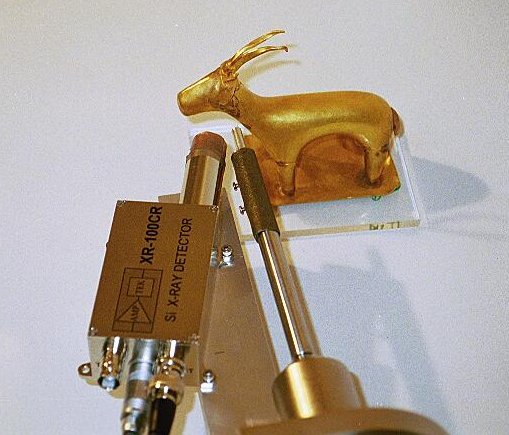
At the request and invitation of the Thera Foundation a group from Amptek Inc. and Photoelectron Corp. journeyed to Thera to analyze a gold ibex that was recently found at Akrotiri. The analysis was performed using x-ray fluorescence techniques (XRF). Other artifacts were also analyzed, ranging from pottery to wall paintings and daggers. The x-ray detector used was the Amptek XR-100CR and the x-ray source was the Photoelectron XRS tube.
The gold ibex was perhaps the most unique object analyzed in that it is the only artifact made of precious metals found at Akrotiri. All other precious objects were removed from the site by Thera inhabitants before the eruption that devastated the island and buried the settlement beneath meters of ash. It is also of note because it comes from an important public building (conventionally called the "building of the benches"), which was in close proximity to the famous Xeste 3 building where the rituals for the young boys and girls of the local elite class took place. The fact that the ibex was found in-situ makes its importance even greater since this object is stylistically unique and it could be considered even as fake in the international art market.
Here is Prof. Doumas' description from the relevant chapter of the catalogue of the new museum:
"Unexpected among the many and wealthy finds of the excavations made for the foundations of the pillars of the new shelter, is the gold figurine found on December 1999. Unique of its kind, it was discovered in mint condition, inside a wooden box (only the imprint has survived) inside a clay chest (larnax), next to a large pile of horns, mainly of goats. Excavation of the find-spot is still in progress and it is therefore too early to draw conclusions about the figurine's significance (I would say that it was offered as a gift from someone coming from the East or that it is a sacrificial object related to worship or other rituals). The figure is hollow and was cast by the "lost wax" method. The legs, neck, and tail of the animal were soldered on after the removal of the inside core. In the finishing process the figure was hammered, as deduced from the tool-marks."
Below is a comparison of two spectra taken from the Gold Ibex. The Goat_1 spectrum was taken from just above the front left leg. This position is free of visual contaminants and considered to be the base spectrum. The Goat_4 spectrum is from the braze/weld of the tail. It shows an increase in the amount of Copper (Cu).

Below are pictures of some of the other artifacts analyzed.
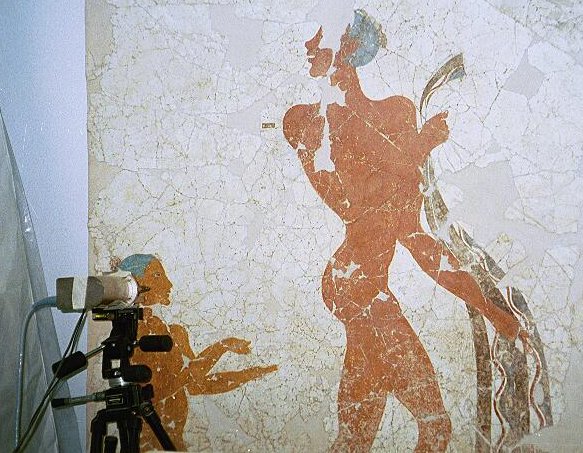
XR-100CR analyzing wall paintings from Akrotiri
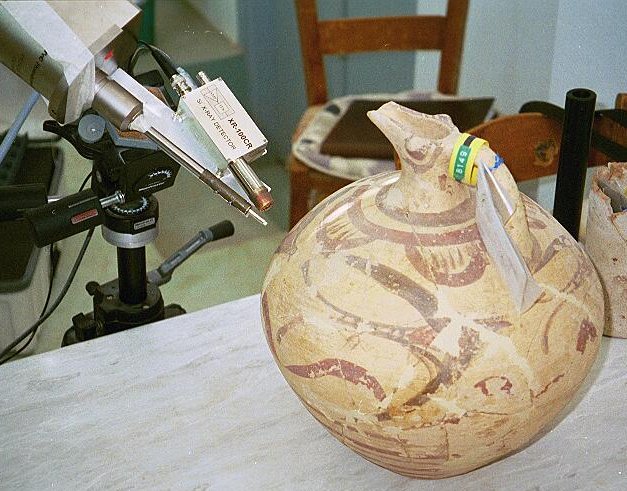
XR-100CR analyzing a bichrome jug
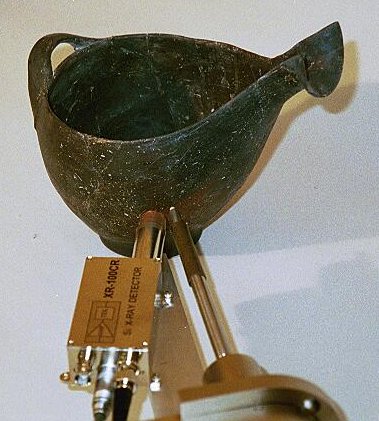
XR-100CR analyzing a sauce boat
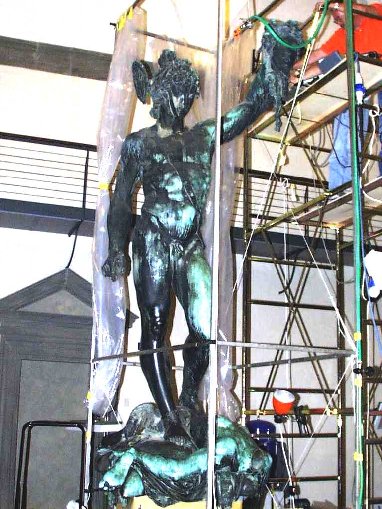
The XR-100CR is shown above performing X-Ray fluorescence of Benvenuto Cellini's Bronze satue of Perseus during its restoration in June, 1998 at the Uffizi Museum in Florence.
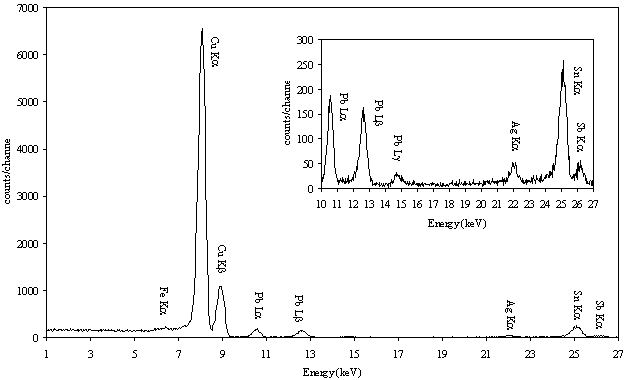
Example of a spectrum of the Perseus right knee showing that the bronze alloy is composed by copper, tin (~3.6%), lead (~6%), antimony (~1%), iron (<1%) and silver (<1%). The composition of the alloy slightly changes in other points of the statue. The x ray tube is equipped with a W-anode and the HV is 35 KV.
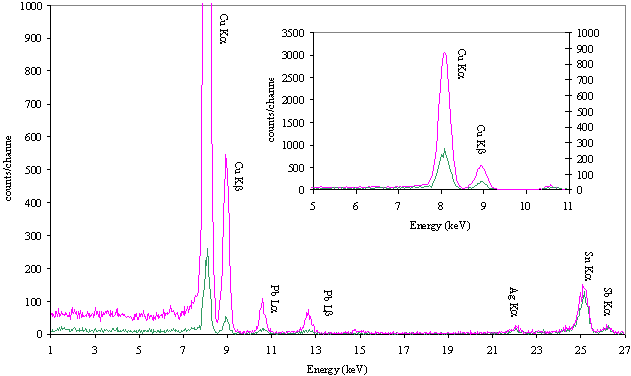
Example of the influence of a green patina on the detected spectrum. It is easy to see that the photons generated in tin atoms (corresponding to the peak at 25.2 keV) penetrate easily the patina while the copper and lead ones are strongly absorbed. In this way you can check the status of the patina and verify its composition.
Reproductions regarding the XRF analysis campaign in collaboration with the University of Sassari, the University of Roma and Lecce and with the Central Institute for Restoration of Roma.Analysis of an ancient bronze statue from Messina, Italy c.16th century.
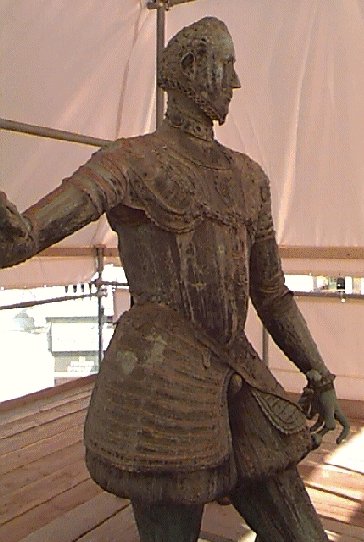
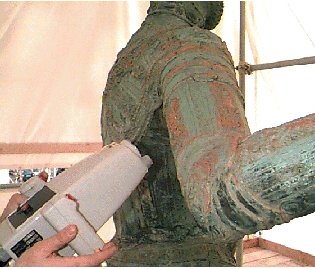
Above is the X-Ray Instrument used for the analysis. Inside the instrument are the XR-100CR and the X-Ray tube. Below is a close-up of the statue indicating the points where the spectra were taken. |
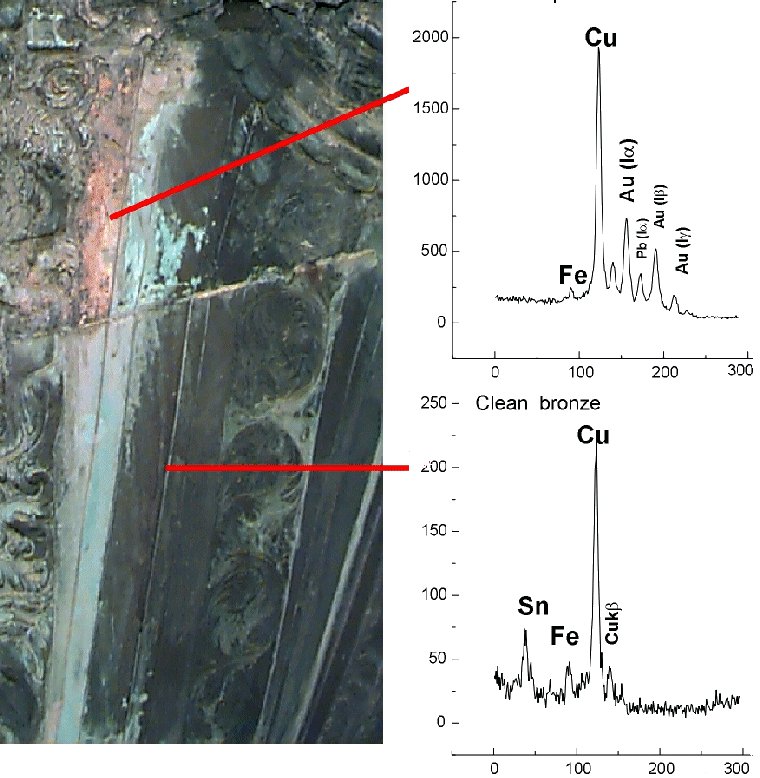 |
The Amptek XR-100T-CZT Detector is shown performing x-ray fluorescence and x-ray diffraction analysis on an ancient Etruscan vase. The portable instrument, which includes the CZT Detector, an x-ray tube and the Amptek MCA8000 Multichannnel Analyzer for data analysis, enables examination of art objects in museums and archeological sites.
The instrument, developed by the National Council of Research in Italy and commercialized by ASSING S.p.A., was described in a paper presented at the TMS Annual Meeting in San Antonio, TX in February 1998. SEXI (Structural & Elemental X-Ray Instrument) is a multifunctional instrument for in-situ, non-destructive, real-time analysis of chemicals, minerals and texture.
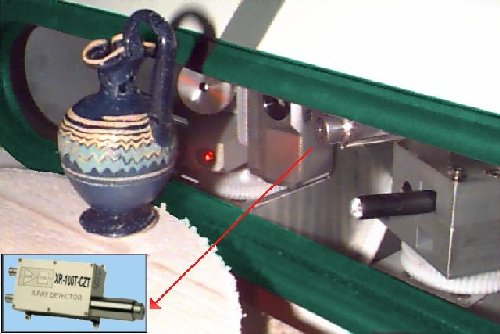
 Above: The XR-100T-CZT performing in-situ nondestructive X-Ray fluorescence analysis on the "Portland" vase from Pompeii at the National Museum of Naples, Italy. |
Revised February 8, 2001